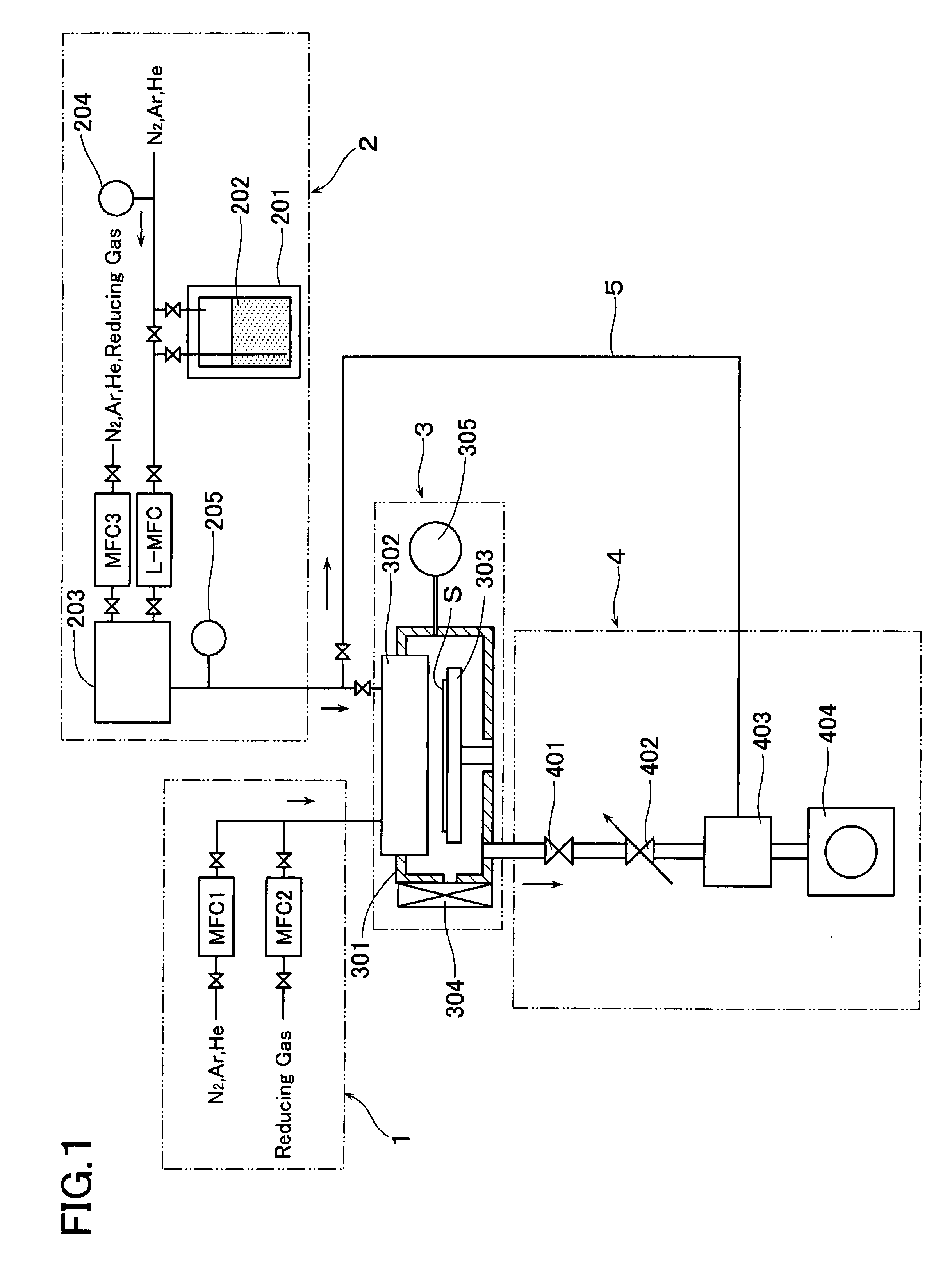Method for forming copper distributing wires
a technology of distributing wires and copper, applied in the direction of resistive material coating, chemical vapor deposition coating, solid-state devices, etc., can solve the problems of difficult formation of copper distributing wires from such a plating solution, difficult to penetrate even deep depth or interior, and long size of contact holes or the like, etc., to achieve excellent step-covering ability and efficiently form a copper-containing film
- Summary
- Abstract
- Description
- Claims
- Application Information
AI Technical Summary
Benefits of technology
Problems solved by technology
Method used
Image
Examples
example 1
[0060]In this Example, a barrier layer consisting of vanadium nitride was formed while variously changing the barrier layer-forming conditions and then a copper-containing film was deposited on the barrier layer to thus variously investigate the initial nucleation conditions.
Step 1:
[0061]A vanadium-containing film was formed on the surface of a substrate S using the CVD apparatus as shown in FIG. 1. In this respect, the substrate S used herein was a wafer (SiO2 / Si) having a diameter of 8 inches, on which a silicon oxide film had been formed.
[0062]The gate valve 304 of the reaction device 3 was opened and then the substrate S was conveyed into the reaction chamber 301 using a robot positioned in the chamber in the proximity of the reaction chamber. The conveyance of the substrate is desirably carried out in a vacuum for the prevention of any adhesion, onto the surface of the substrate, of gases present in the air, for instance, carbon atom-containing gases (such as CO or CO2), oxygen...
example 2
[0158]A vanadium-containing film was formed on the surface of a substrate S using the CVD apparatus as shown in FIG. 1. In this respect, the substrate S used herein was a wafer (SiO2 / Si) having a diameter of 8 inches, on which a silicon oxide film had been formed and then holes and / or grooves having a variety of sizes were formed.
[0159]The gate valve 304 of the reaction device 3 was opened and then the substrate S was conveyed into the reaction chamber 301 using a robot positioned in the chamber in the proximity to the reaction chamber. The conveyance of the substrate is desirably carried out in a vacuum for the prevention of any adhesion, onto the surface of the substrate, of gases present in the air such as carbon atom-containing gases (such as CO or CO2), oxygen-containing gases (such as O2), and water (H2O) or for the prevention of any diffusion or penetration of these gases into the interior of the substrate. Accordingly, the substrate was conveyed into the reaction chamber und...
example 3
[0187]The process for filling holes and / or grooves with a copper-containing film will be described in this Example, while using the substrate provided thereon with a barrier layer and prepared in Example 2.
[0188]The following film-forming processes were carried out using the CVD apparatus as shown in FIG. 1. The substrate provided thereon with the vanadium-containing film prepared in Example 2 was conveyed to a copper-containing film-forming reaction chamber through a transportation chamber (maintained at a vacuum) arranged in the proximity of the reaction chamber 301, while paying much attention not to expose the substrate to the air for the prevention of any oxidation of the surface thereof, followed by placing the substrate on the substrate-placing table 303 maintained at a predetermined temperature. Separately, an SiO2 / Si substrate free of any vanadium-containing film was likewise placed on the substrate-placing table 303 of the copper-containing film-forming reaction chamber 30...
PUM
| Property | Measurement | Unit |
|---|---|---|
| temperature | aaaaa | aaaaa |
| width | aaaaa | aaaaa |
| aspect ratio | aaaaa | aaaaa |
Abstract
Description
Claims
Application Information
 Login to View More
Login to View More - R&D
- Intellectual Property
- Life Sciences
- Materials
- Tech Scout
- Unparalleled Data Quality
- Higher Quality Content
- 60% Fewer Hallucinations
Browse by: Latest US Patents, China's latest patents, Technical Efficacy Thesaurus, Application Domain, Technology Topic, Popular Technical Reports.
© 2025 PatSnap. All rights reserved.Legal|Privacy policy|Modern Slavery Act Transparency Statement|Sitemap|About US| Contact US: help@patsnap.com



